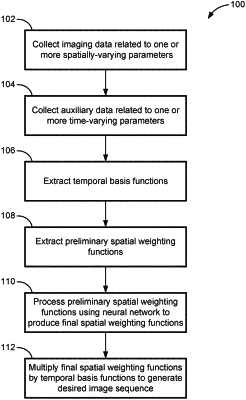| CPC G01R 33/5608 (2013.01) [G01R 33/483 (2013.01); G06N 3/08 (2013.01)] | 20 Claims |

|
1. A method for performing magnetic resonance (MR) imaging on a subject, the method comprising:
obtaining undersampled imaging data from a region of interest of the subject, the undersampled imaging data corresponding to an image sequence having a plurality of image frames;
extracting one or more temporal basis functions from the undersampled imaging data, each of the one or more temporal basis functions corresponding to at least one time-varying dimension of the subject;
extracting one or more preliminary spatial weighting functions from the undersampled imaging data, each of the one or more preliminary spatial weighting functions corresponding to a spatially-varying dimension of the subject;
inputting the one or more preliminary spatial weighting functions into a neural network to produce one or more final spatial weighting functions, each of the final spatial weighting functions corresponding to a respective one of the one or more preliminary spatial weighting functions; and
multiplying the one or more final spatial weighting functions by the one or more temporal basis functions to generate the image sequence.
|